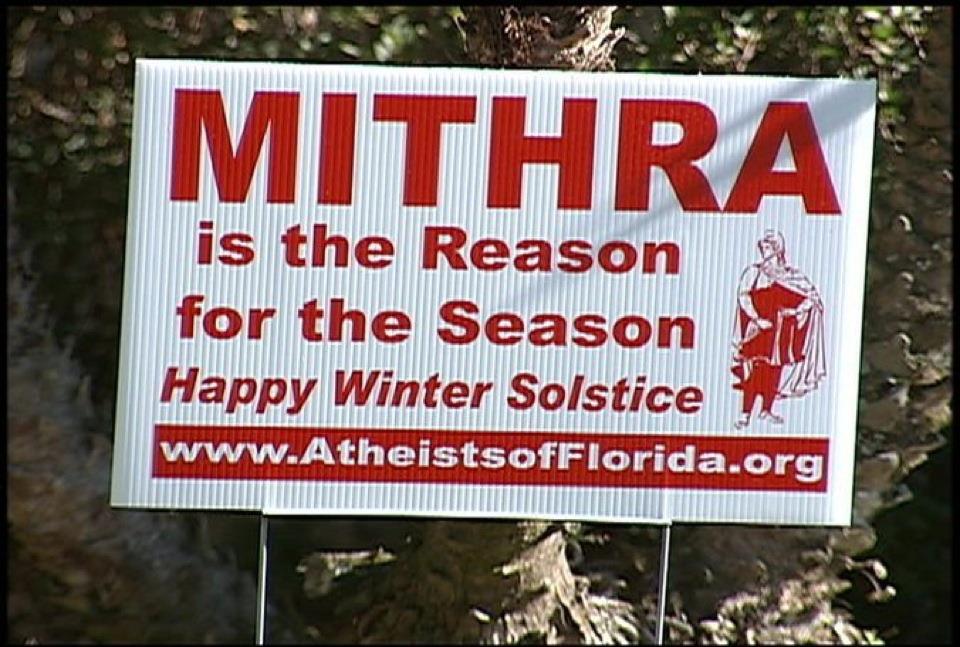
Mithraism and Other Cults in the Roman Empire
In the hundred years before and the few hundred years after Jesus’ death, the most popular religion in the Roman Empire was Mithraism. Many of the main mantras of Mithraism found their way into the Bible and the traditions of Christianity.
It was one of the oldest religious systems on earth, dating from the dawn of written history, circa 2000 BCE, long before Judaism, and before the primitive Iranian race divided into the branches that became Persian and Indian. It dominated Persia and the vast regions of the Orient in ancient times. Zoroaster, a Persian philosopher who gave final form to the faith, lived at least six hundred years before Christ, so when the Christ myth was new, Mithraism was already ancient.
It involved the idolization of the Indo-Iranian sun-god Mithra. It was a monotheistic religion, a feature sometimes falsely claimed to be peculiar to the Abrahamic traditions.
The Persians who practiced Mithraism influenced the Jewish scripture writers during the Babylonian Captivity.
The religion entered Europe following the conquests of Alexander the Great. The faith found its way to Rome in the 60s BCE, when Pompey’s legions first encountered it in Syria and brought it back home. Its foremost fans in the Roman Empire were the legionnaires (who were the soldiers in a Roman legion.)
It spread with great rapidity, and was patronized and protected by a number of Roman emperors up to and including Constantine (Emperor from 306-337 CE.) Several of them built temples to Mithras. By the year 200 CE, it had flourished throughout the empire. It had spread widely throughout the army, and among traders and slaves.
Sites of Mithraic worship have been found in Armenia, Britain, Bulgaria, Germany, Hungary, Israel, Italy, North Africa, Persia, Romania, Syria, and Turkey. It reached its zenith during the third century, only to be stamped out by Christianity in the fourth.
There were no Mithraic scriptures, and no texts written by its adherents have survived. Most of what we know about this cult has been surmised only from the archaeological evidence. Consequently, historians often have markedly different spiels about the details, and the topic of Mithraism’s influence on Christianity is a lively one on the internet.
The religion revolved around reverence of the sun. The character Mithras was the son of the “sun god.” Mithras represented fidelity, manliness, and bravery. The cult emphasized fellowship and brotherliness and a secret bond among its members. It excluded women.
The mysteries of Mithras were celebrated in underground temples, built in imitation of caves, called methraei.
In every Mithraic temple, the place of honor was occupied by a tauroctony, an image of Mithras killing a sacred bull.
Mithras is depicted as an energetic young man, wearing a cap, a short tunic that flares at the hem, pants, and a cloak that streamed out behind him. He grasps the bull to force it into submission, with his knee on its back and one hand heaving back its head, while he stabs it in the neck with a short sword.
This scene was reenacted in real life, when each initiate into the religion was baptized in the bull’s blood, partaking of its life-giving properties.
Joseph Wheless, writing in the 1930s, provided some of the following insights into Mithraism. (http://www.infidels.org/library/historical/joseph_wheless/forgery_in_christianity/chapter_1.html)
Mithras was the mediator between God and humans. There was an ethical system built upon the principle that a war raged between good and evil. A Good Spirit had given men his divine revelation and law through the prophet Zarathustra (Zoroaster). An Evil Spirit tempted people to transgress the Law. Humans had free will, able to place themselves on the side of good or evil. The believers were good guys who battled on Mithras’ side.
Virtues and vices were enumerated and estimated. Special value was attributed to the virtues of adherence to religious practices, truthfulness, purity, and generosity to the poor. Importance was placed on the necessity of goodness in thought, word, and deed.
After death, one’s destiny was decided according to whether the Good Spirit had been obeyed. It was hoped one’s soul would pass over a bridge into a happy eternity, heaven. Heresy, untruthfulness, perjury, sexual sins, violence, and tyranny were especially frowned upon. The wicked soul fell from the bridge into hell.
It is likely that Paul, the creator of Christian theology, incorporated Mithraic ideas into what became Christianity. Some commentators have even suggested Paul was a Mithraic priest. Christian pioneers copied details of Mithraism too. As a result, there are some remarkable similarities between Mithras and Jesus. (http://www.youtube.com/watch?v=qBfAHsUHtiY&feature=player_embeddedhttp://jdstone.org/cr/files/mithraschristianity.html , http://www.near-death.com/experiences/origen048.html , http://www.jesusneverexisted.com/gospel-mithras.html).
Mithras’ virgin mother was the “mother of God.”
Mithras was born on the twenty-fifth of December, three days after the winter solstice. Long before Jesus, every year in Rome, in the middle of winter, his birth was celebrated. The sun “dies” on December 22, the winter solstice, when it stops its movement south. On December 25, the Natalis Invictis, the rebirth of the winter sun occurs, and the sun resumes its movement north. At the first minute of December 25, priests in white garments celebrated the birth of Mithras, the son of God. The temples of Mithras were lit with candles, and boys burned incense. It was only in the fourth century that Western Christians chose the twenty-fifth of December to celebrate Jesus’ birth.
Mithras was baptized and remained celibate throughout his life. He performed miracles. He was called “the Good Shepherd” and the “Light of the World,” terms that came to be used when referring to Jesus.
Mithras celebrated a “Last Supper” with his twelve disciples, who each stood for a sign of the zodiac.
Mithras sacrificed himself by dying on a cross for the sins of mankind. His body was laid to rest in a rock tomb. He descended into the underworld, and appeared in heaven three days later.
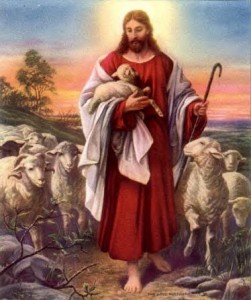 Sunday was the sun god’s holy day. Onto Jesus’ head fell Mithras’ sun disc, the halo.
Sunday was the sun god’s holy day. Onto Jesus’ head fell Mithras’ sun disc, the halo.
For those who worshipped Mithras, invoking his name was supposed to heal the sick and work miracles. They believed Mithras would grant them immortality and eternal salvation in the world to come. They drank wine and ate bread, which symbolized the blood and body of Mithras.
There were “fathers” of the Mithraic religion. Their chief, who lived in Rome, was called Pater Patratus. He wore a red cap and a ring and carried a shepherd’s staff, attire afterwards adopted by Christian bishops.
At the end of time, the story is strikingly similar to that of the Apocalypse in the book of Revelations. A colossal combat takes place between the savior, Mithras and demons, who he destroys. Mithras orchestrates the resurrection of the dead, the judgment and then the renewal of the whole world. A terrible fire rages, which cleanses all creatures; the wicked are cleansed of all stains. A new heaven and earth appear.
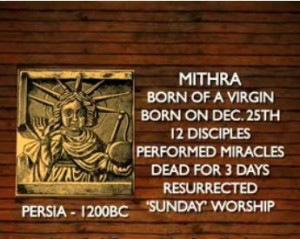 Mithraism was flexible, universal and appealed to the men in all classes in society, yet Mithras was not an historical god-man savior. Nor was he directly connected to Judaism, which I think the government was trying to undermine. He had to be replaced by a more suitable candidate; someone Jewish who the common people could relate to. Enter Jesus.
Mithraism was flexible, universal and appealed to the men in all classes in society, yet Mithras was not an historical god-man savior. Nor was he directly connected to Judaism, which I think the government was trying to undermine. He had to be replaced by a more suitable candidate; someone Jewish who the common people could relate to. Enter Jesus.
The Church Fathers Justin, Origen, and Tertullian were very familiar with Mithraism. (http://www.sacred-texts.com/bib/cv/pch/pch70.htm , http://www.religionfacts.com/greco-roman/sects/mithraism.htm ). The standard explanation they gave for the unmistakable similarities with Jesus was contemptible; that Satan had gone back in time and copied contemporary Christianity. Critics at the time were not slow to point to the truth: Christianity had simply reproduced the popular beliefs of a prominent pagan cult.
There were some differences between Christianity and Mithraism. There were no bulls in Christianity. Mithraism was tolerant of other cults; Christianity was exclusive, condemning every other religion in the world, even Judaism.
When Christianity became the official religion of the empire, Mithraism was driven from the scene by attacks from Christians. It had no hierarchical organization, lacked a professional clergy, and was heavily dependent upon State patronage, so soon came to an ignominious end. During the reign of Emperor Gratian (367–383 CE), its sanctuaries were sacked of their wealth and wound up. Christians seized Mithra’s cave-temple on the Vatican Hill in 376 A.D. The Vatican was built on top of it. (http://www.ambrosiasociety.org/mithra__avesta.html , http://www.websitesonadime.com/ffwic/mithra.htm). Christianity’s architectural and theological foundations were both Mithraic!
Thirty years later, the Emperor Theodosius made worship of Mithras punishable by death. Mithraism vanished, vanquished by the cult of Christ.
Other Cults
In the first four centuries CE, there was a huge trade network from Europe all the way to China. Goods were not the only commodities traded; philosophies, traditions and manuscripts were shared amongst the world’s people. Rome absorbed the gods of the provinces it conquered. By the end of the first century, there were so many foreign gods that almost every day of the year celebrated some divinity. Roman citizens were encouraged to give offerings to these gods to maintain the “Pax Deorum” (the peace of the gods.) These cults, including Christianity, vied with their contemporaries for supremacy, and borrowed ideas from each other. Gods who became men, sons of gods, births to virgin mothers on or near the 25th of December, baptisms, miracles, healings, deaths due to hanging on trees or crucifixion, risings from the dead, and belief being the basis for salvation, were all traditional themes. (http://freetruth.50webs.org/B1a.htm). Here are some examples.
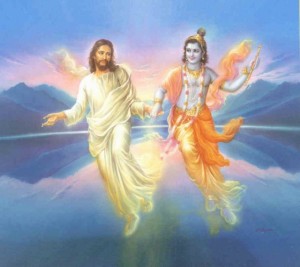 Krishna, the central character of an Indian myth dating back to 1400 BCE, had his birth signaled by a star in the East and attended by angels and shepherds. His father was a carpenter. A tyrant slaughtered thousands of innocent infants to get the baby. Krishna survived and grew up to raise the dead and heal lepers, the deaf and the blind. He was killed around age 30 and the sun darkened. He rose from the dead and ascended into heaven, and became the second person of a trinity.
Krishna, the central character of an Indian myth dating back to 1400 BCE, had his birth signaled by a star in the East and attended by angels and shepherds. His father was a carpenter. A tyrant slaughtered thousands of innocent infants to get the baby. Krishna survived and grew up to raise the dead and heal lepers, the deaf and the blind. He was killed around age 30 and the sun darkened. He rose from the dead and ascended into heaven, and became the second person of a trinity.
Christianity has repeatedly failed to make any headway in India. One of the reasons is that many Indians have recognized it as an imitation of their own traditions. ( http://www.religioustolerance.org/chr_jckr1.htm).
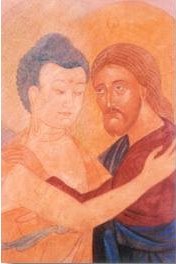 Buddhist monks travelled to Egypt, Greece and Asia Minor four centuries before Jesus. Buddha, traditionally said to have lived c 600 BCE, was born to the virgin Maya. A king threatened the baby’s life. He was baptized in water, taught in a temple at age 12, healed the sick, fed 500 men from a small basket, walked on water and taught the parable of the prodigal son. His followers were obliged to take vows of poverty and to renounce the world, sex and family. ( http://jdstone.org/cr/files/j_buddah.html).
Buddhist monks travelled to Egypt, Greece and Asia Minor four centuries before Jesus. Buddha, traditionally said to have lived c 600 BCE, was born to the virgin Maya. A king threatened the baby’s life. He was baptized in water, taught in a temple at age 12, healed the sick, fed 500 men from a small basket, walked on water and taught the parable of the prodigal son. His followers were obliged to take vows of poverty and to renounce the world, sex and family. ( http://jdstone.org/cr/files/j_buddah.html).
Dionysis of Greece was born in a manger to a virgin on 25th December, turned water into wine, was eaten in a Eucharistic ritual, and in one version of events rose from the dead on March 25th.
Stories about Osiris of Egypt predate Christ by thousands of years. His birth was announced by 3 wise men. He was called the resurrection and the Life and the Good Shepherd. He suffered, died and rose again. His flesh was eaten as wheat cakes. (http://www.religioustolerance.org/chr_jcpa2.htm).
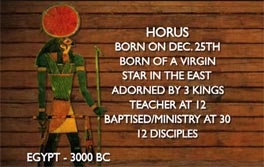 He had a son called Horus, (http://www.religioustolerance.org/chr_jcpa5b.htm), whose birth was announced by a star in the east and attended by 3 wise men. He was born of the virgin Isis-Meri on the 25th December in a cave. At age 12 he was a teacher in a temple, then disappeared for 18 years, returned into circulation and was baptized at age 30. He had 12 disciples, performed miracles, exorcised demons, raised men from the dead, walked on water, delivered a sermon on the mount, was crucified between two thieves, and was buried for 3 days before he was resurrected from the dead.
He had a son called Horus, (http://www.religioustolerance.org/chr_jcpa5b.htm), whose birth was announced by a star in the east and attended by 3 wise men. He was born of the virgin Isis-Meri on the 25th December in a cave. At age 12 he was a teacher in a temple, then disappeared for 18 years, returned into circulation and was baptized at age 30. He had 12 disciples, performed miracles, exorcised demons, raised men from the dead, walked on water, delivered a sermon on the mount, was crucified between two thieves, and was buried for 3 days before he was resurrected from the dead.
There were many others, including Adduk and Marduk of Assyria, Adonis, Aesclepius, Apollo, Hercules and Zeus of Greece, Alcides of Thebes, Hermes of Greece/Egypt, Issa of Arabia, Jupiter of Rome and Serapis of Egypt who had striking similarities to the Christian mythology.
Jesus had to be distinguished from these other gods, so the church fathers made a big deal out of how he came “in the flesh.” They then derided other gods as mythical.
It’s obvious that what became the Christian faith was a heady, plagiarized mix of Judaic, Mithraic, and other pagan myths. The existence of all these characters, sharing so many characteristics, constitutes an ancient universal mythos that has not been recognised by everyday Christians.
References:
Atwill, Joseph “Caesar’s Messiah”
http://www.jesusneverexisted.com/Mithraism.html
http://www.near-death.com/experiences/origen048.html
http://www.crystalinks.com/mithraism.html
http://www.truthbeknown.com/mithra.htm
http://www.askwhy.co.uk/christianity/0690Mithras.php
http://www.tyndalearchive.com/scriptures/www.innvista.com/scriptures/compare/mithra.htm
http://en.wikipedia.org/wiki/Development_of_the_Jewish_Bible_canon
http://www.innvista.com/culture/religion/deities/mithra.htm
http://www.answering-christianity.com/abdullah_smith/cross_pagan_origins.htm
http://www.christianity-revealed.com/cr/files/mithraschristianity.html
http://www.infidels.org/library/historical/joseph_wheless/forgery_in_christianity/
http://armageddonconspiracy.co.uk/The-Mithras-Deception(1753794).htm
http://www.hiddencodes.com/sherry/churches.htm
http://www.youtube.com/watch?v=8U1Grl4HSRU
http://www.youtube.com/watch?v=Nb1IfFMoIZQ
http://www.egodeath.com/bensonmysteryrels.htm
http://fuzzyquark.comxa.com/original.html
http://www.youtube.com/watch?v=ljRKhZ81aqY
https://www.youtube.com/watch?v=4lGG1fgSkl4
https://www.youtube.com/watch?v=AJk_nBNqejg

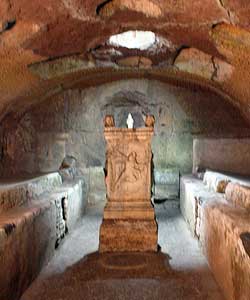
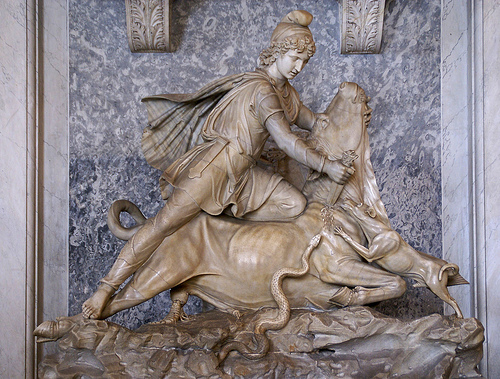
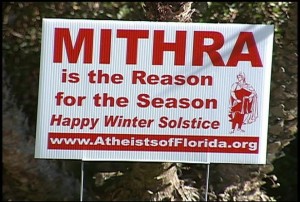
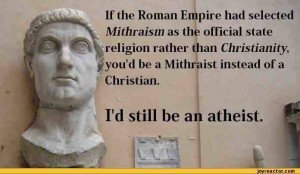
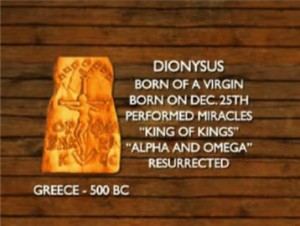
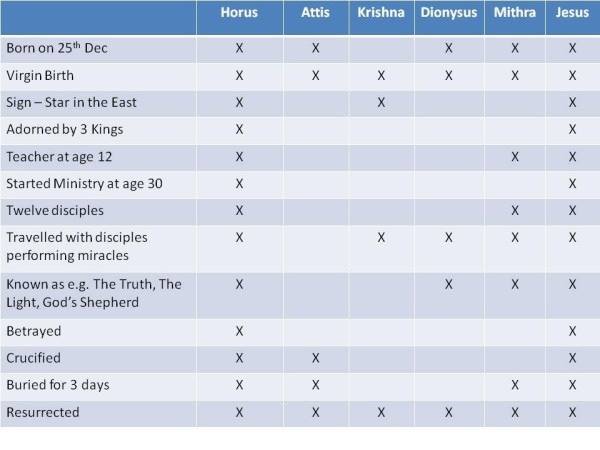
To say this page lacks any credible scholarship is based on preconceived biases. Modern scholars who have studied Mithraism (to the extent a mystery religion can, in fact, be studied) agree that to make overly simplistic claims of the connections between Christianity and Mithraism as an overreach at the least and classically dilettante-like in source gathering. The only connection between the two religions is the date of December 25, and this attested to by an early Christian writer who admitted to the date as being chosen (We hold this day holy, not like the pagans because of the birth of the sun, but because of him who made it) Source: “Christmas: Oxford Concise Dictionary of World Religions,” 2004)
This article, as well as others, needs more sources. To extrapolate ideas between the various religions present in ancient Rome during the 2nd and 3d Centuries respectively, is, at least in this case, to argue for roughly 1% of the people under Roman influence. The rest being clearly pagan to one extent or another.
As a practicing atheist, this sort of “scholarship” does not help the argument but rather makes the rest of us look like idiots for not performing due diligence.